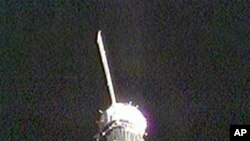Three astronauts have docked their Russian space capsule to the International Space Station, where they will live for the next six months. The mission marks a shift toward greater reliance on the Russian space program, as the U.S. shuttle program gets set to retire next year.
Russian cosmonaut Oleg Kotov guided the capsule into its berth at the station, about two days after he and his two companions launched into space from the Baikonur Cosmodrome in Kazakhstan. He is joined on the mission by U.S. astronaut Timothy Creamer and Soichi Noguchi of Japan.
"Contact. Capture confirmed. Docking confirmed. Three new Christmas stockings are hung at the International Space Station," said the mission controller.
Unlike recent missions, the Soyuz capsule will not return to Earth soon after delivering supplies and swapping out a crew member to live aboard the station. Instead, the crew will remain at the station for the next six months to perform a series of tasks, such as conducting a space walk and receiving two planned space shuttle flights.
Typically, the Russian Soyuz and U.S. space shuttle fleets alternate making trips to the station. But, now, the Soyuz program is taking on the primary role in servicing the station, as the U.S. space agency prepares to retire the shuttle fleet later next year.
NASA spokesperson Kylie Clem says the Russian space agency will expand its role at the station, where in the past it maintained at least one Soyuz capsule to evacuate astronauts in case of emergency.
"Those are still there, but now we will have two of those Soyuz space craft there at the same time to support up to six crew members to live there continuously," said Kylie Clem.
The station expanded the number of crew members earlier this year, thanks to a series of U.S. shuttle missions that delivered new modules to the orbiter. The shuttle Discovery ferried new solar arrays and batteries to the station, and Endeavour delivered a Japanese-built science module used to perform experiments in space.
There are only five shuttle missions remaining to finish work at the station, before U.S. officials retire the fleet and focus on building a new vehicle that may travel to the moon or Mars.
Kylie Clem says the the next flight is set for February, when Endeavour will deliver the U.S.-built Tranquility module.
"It is another connecting port that will be added to the station," said Clem. "It is one of the last pressurized modules we are adding. We will consider the station pretty much complete at that point."
The three astronauts arriving at the station Tuesday will help install the Tranquility module when it arrives next year.
